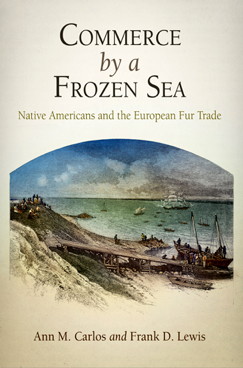Some economic histories are valuable because they provide insights into events and places previously not fully explored, while others contribute through a well-formulated test of economic propositions. In Commerce by a Frozen Sea, Ann M. Carlos and Frank D. Lewis have given us a marvelous melding of the two. The authors have written a carefully researched and well-organized discussion of the early fur trade in the very northern reaches of North America as well as a fascinating use of basic economic theory. The book extends our understanding of the overall extent of the trade and the interaction between the European traders — primarily the French and British — and indigenous tribes. Europe wanted furs, primarily beaver, and the resident tribal groups valued the commodities available from the more economically-developed countries.
When Adam Smith published his Wealth of Nations in 1776, he devoted a bit more than a page to the Hudson Bay Company, which was over a hundred years old at that point, having been created by royal charter in 1670. Smith places his discussion of the Company in his section discussing the costs and benefits of joint stock companies, and thinks the Hudson Bay Company probably had a reasonable level of profits, despite some of the principal-agent problems inherent in such organization.
Smith could have made the Company and its relations with the Native Americans in the region around Hudson Bay a prime example of one of his basic assumptions about human nature, “the propensity to truck, barter, and exchange one thing for another.” He also argued that the division of labor is limited by the extent of the market and he would have found in the activities of the Hudson Bay company a surprisingly robust case study of entrepreneurial efforts to further extend the market and hence the division of labor.
Commerce by a Frozen Sea is, at its core, an account of the gains from trade when two very different cultures with very different resources and productive abilities come into contact. And that contact itself was not exogenous, but driven by farsighted individuals who were able to organize trade across thousands of miles in the most difficult of circumstances. The Hudson Bay was frozen for most of the year, so the outposts or “factories” along the edges of the Bay depended upon the yearly vessel that would bring rations for the Europeans stationed at the factory as well as trade goods. These goods were often ordered specifically by the Indians the year before. The ship would then load the furs that had accumulated at the trading post for the return trip to Europe.
Carlos and Lewis provide useful insights into several issues surrounding eighteenth-century fur trading. First, the Indians were careful traders and industrious harvesters of furs and were very sensitive to price fluctuations, both of the goods they were selling and the commodities (needles, guns, axes, textiles) that they wanted to receive. There is no evidence that the natives were an indolent lot, trading to a point of satiation, and then ignoring more opportunities for exchange. Instead the trade was between two relatively equal groups and the Indians were careful shoppers who knew what they wanted and what the relative prices were at French as compared to British trading posts.
Second, alcohol played little role in the trading patterns. Some natives traded for alcohol, but their overall consumption was quite modest and the Hudson Bay Company did not try to use alcohol as a lubricant for trade. In fact, The Company acted as a firm that cared a great deal about long-term relations and thought that the use of alcohol during trading created suspicion and made future trades less likely.
Third, there was little violence in the trading relations. The Hudson Bay outposts were far apart and had only 20 to 30 men at them. Hence, if the Native Americans would have wanted to overwhelm a post and plunder the store of tradable commodities they easily could have done so. They, like the European traders, however, saw the gains from a long-term relationship and did not want to jeopardize the possibility of future trades.
Fourth, the English clearly understood gains from specialization, and believed that the Native Americans could harvest beaver and other furs much more cheaply than European trappers. Hence, the trading posts were just that, a place where two cultures could interact to provide substantial gains for both groups.
Finally, there was a general understanding of the problem of over-exploitation of an open access resource, and where the British has a monopoly on trade they were careful to discourage over-trapping. In regions where there was an interface with French traders, and when a single tribe did not have complete control of an area, over-exploitation did occur. Also, some of the cultural norms of the tribes that allowed harvesting for survival meant that it was difficult to establish and enforce well-defined property rights to fur-bearing animals, particularly beaver.
Carlos and Lewis also provide interesting insights into long-term growth issues. They call the eighteenth century “the golden age” for the tribes in northern regions. Their per capita income compared favorably to working class British. That was because they controlled a valuable resource, primarily beaver pelts that were valued in Europe for hats. Once that resource was exploited and most of the gains from trade had been realized, there was little basis for ongoing economic growth, hence over the long-run the tribal communities did not experience the increases in per capita income that occurred in Western Europe and the parts of North American with permanent European settlers.
This is a delightful book to read. It is fascinating in terms of its insights into the trading culture of a particular place and time and it also provides useful correctives to many misconceptions about various aspects of that trading.
Originally reviewed for EH.Net. Published by EH.NET (November 2010)
Ann M. Carlos and Frank D. Lewis, Commerce by a Frozen Sea: Native Americans and the European Fur Trade. Philadelphia: University of Pennsylvania Press, 2010. viii + 260 pp. $50 (hardcover), ISBN: 978-0-8122-4231-7.





